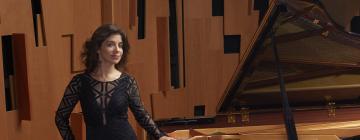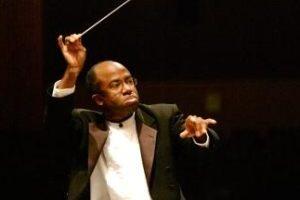
Like the amazing week that preceded it, the Oakland East Bay Symphony's concert last Friday night at the Paramount Theatre was all about moving forward through history. Conductor Michael Morgan surprised by reversing the typical program order, placing the ballet and concerto in the second half and opening with the weightiest piece, Brahms' Symphony No. 3. As he explained, the week's historic resonances inspired a revamped program that traveled from the old world (Brahms) to the new (Copland) to the global present, in a new work by Petaluma composer Nolan Gasser, and the success of this choice made programming conventions seem arbitrary.
The lingering spirit of the Obama inaugural also brought some added resonances to the night, whether overtly — opening the program with a genuinely moving Star-Spangled Banner — or unexpectedly, as the "Simple Gifts" section of Appalachian Spring mirrored the Shaker hymn's use in John Williams' inaugural chamber piece. For the Brahms, the orchestra's sound was rich and balanced from the opening downbeat, and Morgan culled clear lines out of the work's thick textures throughout the piece. There was a rightness to all of Morgan's tempos, letting the music really speak, and creating a context for his deft handling of the work's ingenious rhythmic shifts. The straightforward opening Allegro, the graceful, gorgeous Andante, and the beautifully woven textures of the third-movement Poco allegretto all brought their own pleasures, leaving plenty of room to build the fierce drama of the concluding Allegro.
An Intriguing Premise, A Dream Team
Gasser's World Concerto for Cello and Orchestra arrived with great promise. This was a world-premiere commission written for cellist Maya Beiser and a trio of fellow soloists representing the musical traditions of China, India, and the Arab world: Jiebing Chen (erhu), Aruna Narayan Kalle (sarangi), and Bassam Saba (oud) — accompanied, in an uncredited performance, by percussionist April Centrone. The mix of outstanding soloists and programmatic conceit — the sonic depiction of contemporary cultures meeting and moving closer together — seemed ready to bear beautiful fruit.
As often happens with first performances, the work emerged with many things to recommend it, but some other elements in need of repair. The three-movement musical narrative depicts the cello's emergence as an old-fashioned heroic soloist: first in stormy dialogue with the orchestra, then in deepening contact with the non-Western soloists and the worlds they represent, and lastly in a fully realized dialogue and synthesis representing an ideal sort of global village. Beiser is the right soloist for this work, given the poly-stylistic virtuosity and Kronos-like global vision for her instrument that she has demonstrated in many other pursuits.
The other three soloists are all leaders in their own musical spheres. Gasser himself has an eclectic musical background and lists among his accomplishments a chief role in creating the Music Genome Project that links musical genres for the Pandora internet radio site. The work lived up to this promise at times, but in many ways proved problematic in both conception and execution.
A Tricky Balancing Act
The opening movement grew out of a dialectic between demonstrative, intense solo lines and similarly brief and forceful figures in the orchestra. One early challenge emerged here that continued through much of the work, with the soloist often overbalanced by the orchestra when they joined forces, despite the cellist being miked and amplified. Although amplification made sense for this piece and worked well for the other soloists, for Beiser it detracted from the effectiveness of her playing, as her appealingly throaty, piercing tone turned harsh and metallic through the sound system.
The second movement posited the cellist, who sounded more relaxed and fluent at this point, as a wanderer in dialogue with the musical cultures she encountered, interacting in exploratory and even uneasy conversation with the erhu, then the sarangi, then the oud. Gasser clearly did his homework in coming up with scales, rhythms, and figures for each of the trio of soloists that answered the cello in a reasonably idiomatic fashion, though the music tended to linger on the surfaces of the styles it explored. As the work's program demands, the varied musical elements coalesced much more in the third movement, with its depiction of the cellist's culture entering into a more fully realized and balanced conversation with its counterparts. The same sequence of soloists introduced characteristic ideas, with the cellist then picking them up, the paired instruments then engaging in a sort of celebratory union. There were also compelling cadenzas — written out for Beiser, improvised by the other soloists. Beiser finally projected a truly commanding musical presence at this point, and the other soloists' improvised contributions, especially Saba's soulful playing, were often strikingly beautiful.
Although the music itself, without preconception, is what really matters, it seemed to me that World Concerto veered off troublingly from its intended programmatic effect. Gasser's notes for the piece explained that the East/West synthesis was meant to convey a sense of global cooperation, but the repeated conceit of the cello "hearing" non-Western musical ideas, repeating them, then expanding upon them in the role of musical leader suggested something more like good old Western plundering. Perhaps the 19th-century concept of the heroic soloist simply isn't the best vehicle for conveying and embracing 21st-century aspirations. There was much worthy material in this concerto, but its players deserved a realization richer and more textured than the work is in its present state.
Serene, Strong Spring
Opening the concert's second half, Assistant Conductor Bryan Nies led the orchestra through a beautifully shaped and heartfelt rendition of Copland's Appalachian Spring. Nies was especially patient with his tempos and the development of the piece, and the unhurried unfolding spotlighted the composer's wonderfully clear orchestration and his ability to let new ideas steal their way into the music and unexpectedly take center stage.
Along with fine ensemble playing, there was beautiful solo work from many players, notably concertmaster Dawn Harms and clarinetist Michael Corner. The only serious drawback to the performance came not from the players but the audience, which hacked its way through so much of the piece that Appalachian Influenza seemed a more fitting title. Whatever malady beset my fellow concertgoers, I only admire Nies and the players more for bringing forth such a serene and stirring performance.

